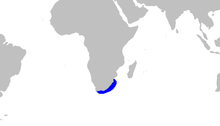埃氏寬瓣鯊
| 埃氏寬瓣鯊 | |
|---|---|

| |
| 科學分類 | |
| 界: | 動物界 Animalia |
| 門: | 脊索動物門 Chordata |
| 綱: | 軟骨魚綱 Chondrichthyes |
| 亞類: | 鯊總目 Selachimorpha |
| 目: | 真鯊目 Carcharhiniformes |
| 科: | 貓鯊科 Scyliorhinidae |
| 屬: | 寬瓣鯊屬 Haploblepharus |
| 種: | 埃氏寬瓣鯊 H. edwardsii
|
| 二名法 | |
| Haploblepharus edwardsii Schinz, 1822
| |

| |
| 埃氏寬瓣鯊的分布範圍 | |
| 異名 | |
|
Scyllium edwardsii Schinz, 1822 | |
埃氏寬瓣鯊(學名:Haploblepharus edwardsii)是貓鯊科寬瓣鯊屬下的一種鯊魚,僅分布於南非附近的溫帶水域。埃氏寬瓣鯊是底棲魚類,多分布於岩質或沙質海床上。其棲息的深度最淺可達潮間帶,而最深則是水深130公尺處。該魚一般可長到60公分長。其身體上有數道邊緣黯淡的亮橙色馬鞍狀條紋,背部密布有白色斑點。
在感受到威脅時,埃氏寬瓣鯊會蜷縮成一團,並用尾巴覆蓋面部,因此在南非有「羞鯊」(Shyshark)和「甜甜圈」的俗名。該魚主要以甲殼類、蠕蟲和小型硬骨魚為食。埃氏寬瓣鯊是卵生動物,母鯊會將卵囊放置於水下的礁石之中。該魚由於其體型小而商業價值低,故常被漁民拋回海中。然而,由於其分布範圍小且易受到棲息地破壞和過度捕撈的影響,IUCN將其評為「瀕危」(EN)。
物種命名
[編輯]
1760年,英國生物學家喬治·愛德華茲根據採集於好望角附近的標本描述了埃氏寬瓣鯊,並將稱為Catulus major vulgaris。目前,這三具標本已遺失[2]。1817年,法國博物學家喬治·居維葉根據愛德華茲的描述將該物種稱為「Scyllium D'Edwards」,但他並未給出正式的二名法學名。1832年,德國生物學家弗雷德里克·西格蒙德·沃爾格特在將居維葉的著作翻譯至德語時正式將該物種命名為Scyllium edwardsii。然而,2011年有學者發現瑞士生物學家海因里希·魯道夫·辛茨早在1822年就已正式描述埃氏寬瓣鯊,故國際動物命名法委員會將該物種的命名人改為辛茨[3][4][5] 。1913年,美國魚類學家薩繆爾·格曼建立新屬寬瓣鯊屬並將埃氏寬瓣鯊劃入其中,該魚的學名也因此變為Haploblepharus edwardsii[6]。
埃氏寬瓣鯊曾有「開普」和「納塔爾」兩個亞種,但後者在2006年獨立成新物種納塔爾寬瓣鯊[7]。在英文學術文獻中,該魚常被稱為「快樂的埃迪」(Happy Eddie),源於該魚最初的命名人愛德華茲,而在民間也因該魚會在遇險時蜷曲身體並遮住面部的習性將其稱為「羞鯊」(Shyshark)和「甜甜圈(Doughnot)」[5]。
種間關係
[編輯]2006年開普敦大學的研究團隊對彼時寬瓣鯊屬的3種鯊魚進行了粒線體DNA測序,結果顯示埃氏寬瓣鯊是該屬最為基幹的一種,其姐妹群包含褐寬瓣鯊與白斑寬瓣鯊[8] 。
外貌描述
[編輯]
埃氏寬瓣鯊比起其他同屬物種要細長,其頭部扁平,吻短且圓[5]。該魚眼大而橢圓,上有一層瞬膜,瞳孔如貓眼一樣為裂瞳。埃氏寬瓣鯊的鼻孔非常大,前有連在一起的三角形皮膚,一直延伸至嘴部。其嘴小,上下顎兩側均有皺紋,內有牙齒27-33顆[6]。不同性別的牙齒形狀不同:雄性的牙齒較長,呈三角形;雌性的牙齒則是較短的五邊形[9]。少數個體會長出一條軟骨連接下顎兩側,使其牙齒的分布更為平均並進而強化其咬合力[10]。
埃氏寬瓣鯊有鰓裂五瓣,位於身體偏上的位置。其背鰭、腹鰭和臀鰭大小相仿。該魚背鰭位置極靠後,兩片分別位於腹鰭和臀鰭最前端之後。其胸鰭寬平,尺寸中等;尾鰭長度約為體長五分之一,為上歪尾,上葉末端有一道非常深的凹痕。其皮膚厚,覆蓋有葉狀的鈣質魚鱗[6]。埃氏寬瓣鯊的背部為深淺不一的褐色,上有8-10條明黃色至紅褐色的馬鞍狀條紋和大量白色斑點。埃氏寬瓣鯊一般可長到60公分,最大長度則是69公分[11]。厄加勒斯角以西的個體相比其他海域的個體體型較小,最多只能長到48公分[5]。
物種分布
[編輯]埃氏寬瓣鯊僅分布於南非附近的大陸架海域,西至西開普省的朗厄班,東至阿爾哥亞灣西岸,早先在北至德班附近海域出現的記錄則很可能是誤判[5]。該魚是底棲魚類,多生活在沙質或岩質的海床上。在越偏東北的海域,埃氏寬瓣鯊會分布於更深的水深。例如在開普敦外海埃氏寬瓣鯊棲息的水深為0-30公尺,而在夸祖魯-納塔爾省海域該魚則生活於40-130公尺水深處。這一現象可能是由於其偏好冷水所致[6]。
生態與習性
[編輯]
埃氏寬瓣鯊在其狹小的分布範圍內較為常見。該魚移動緩慢,常躺在海床上不動[12][13] 。埃氏寬瓣鯊有群居習性,會與同類一起在海床上休息[11]。
捕食
[編輯]
該魚為不挑食的掠食者,長有利於緊咬獵物的牙齒。其獵物種類多種多樣,包括蝦、蟹、鰲蝦、蝦蛄和寄居蟹等甲殼類、鰺、鯷魚和鰕虎魚等硬骨魚類、魷魚等頭足類和管蟲,亦會食用魚類的下水[9]。總的來說,該魚最主要的獵物是甲殼類,其次則是硬骨魚。不同性別的個體亦會偏好不同的獵物:雄性會捕食更多的管蟲,而雌性則會捕食更多的甲殼類[11][14]。曾有人目擊其通過扯斷對方腕足的方式攻擊普通章魚[15]。
天敵與寄生蟲
[編輯]該魚的天敵主要是扁頭哈那鯊之類的大型魚類。非洲毛皮海獅會捕捉埃氏寬瓣鯊並將其拋至空中或是撕咬該魚以取樂。埃氏寬瓣鯊在這一過程中常會受傷甚至死亡。非洲毛皮海獅可能會吃下掉落的肉塊,但很少會吞下整條鯊魚。目前已知黑背鷗會在海獅玩耍時竊走被拋至空中的鯊魚[16]。當感受到威脅時,埃氏寬瓣鯊會立刻蜷縮成一團,並用尾巴蓋住面部,這一行為可能是為了讓自己更難被天敵吞下[5][11]。此外,在人工環境下兩種峨螺Burnupena papyracea和 B. lagenaria會食用埃氏寬瓣鯊的卵囊[17]。
該魚的寄生蟲包括寄生於血液內的錐蟲Trypanosoma haploblephari[18]、寄生於腸道中的線蟲Proleptus obtusus[19]和寄生於體表的橈腳類Charopinus dalmanni 與Perissopus oblongatus[20]。此外,有一等足類Gnathia pantherina的幼體會寄生於該魚的鼻孔、魚鰓與嘴中。該種寄生蟲的口器可扎入宿主體內並使周圍組織嚴重受損,令宿主流血、發炎[21]。
生命周期
[編輯]
埃氏寬瓣鯊是卵生物種,全年皆會繁殖[14]。每次母鯊會產下1-2枚卵囊,並將其黏著於海扇等垂直結構上[11]。其卵囊為棕色,上有貫穿整個卵囊的白色斑紋,在兩端有黏著的卷鬚狀物,外壁薄且有毛絨質感。埃氏寬瓣鯊的卵囊略小於其他同屬物種,長3.5-5公分,寬1.5-3公分[10][22]。魚苗會在3個月後孵化,此時體長約9公分[1]。埃氏寬瓣鯊成年時的體長為35-55公分之間,且會隨海域不同而變化,如其生活於其分布範圍東部深水的個體就會比西部淺水中的個體長得更大[5]。埃氏寬瓣鯊平均壽命為7年左右,而最大壽命則至少為22年[14]。
與人類之間的關係
[編輯]埃氏寬瓣鯊對人類無害,甚至可被人用手抓住[23]。該魚雖由於體型小而商業價值極低,但在錯灣和莫塞爾灣至東倫敦之間的海域常被拖網漁船意外捕獲。漁民一般會將其拋回海中,而釣得埃氏寬瓣鯊的游釣客則一般會將其放生或作為雜魚殺死[10]。目前,該魚只在少數地區有小規模的商業捕撈,一般是用作觀賞魚或是捕捉龍蝦的誘餌。由於其狹小的分布範圍內捕魚活動頻繁,埃氏寬瓣鯊的種群數量自1990年代以來下降了近90%,IUCN將其評為「瀕危」[1]。
參考文獻
[編輯]- ^ 1.0 1.1 1.2 Pollom, R.; Da Silva, C.; Gledhill, K.; Leslie, R.; McCord, M.E.; Winker, H. Haploblepharus edwardsii. The IUCN Red List of Threatened Species. 2020, 2020: e.T39345A124403633 [19 November 2021]. doi:10.2305/IUCN.UK.2020-2.RLTS.T39345A124403633.en
 .
.
- ^ Edwards, George. Gleanings of Natural History, exhibiting figures of quadrupeds, birds, insects, plants &c... Part 2. London: Printed for the author, at the College of Physicians. 1760: 169–170, Plate 289 [2023-05-08]. (原始內容存檔於2023-05-08) (英語及法語).
- ^ Schinz, Heinrich Rudolf. Das Thierreich eingetheilt nach dem Bau der Thiere als Grundlage ihrer Naturgeschichte und der vergleichenden Anatomie 2. Stuttgart und Tübingen: in der J.G. Cotta'schen Buchhandlung. 1822: 214, Footnote [2023-05-08]. (原始內容存檔於2023-05-09) (德語).
- ^ International Commission on Zoological Nomenclature. Opinion 2056 (Case 3186). Squalus edwardsii (currently Haploblepharus edwardsii; Chondrichthyes, Carcharhiniformes): attributed to Schinz, 1822 and edwardsii conserved as the correct original spelling of the specific name. Bulletin of Zoological Nomenclature. 2003, 60 (3): 250 [2023-05-08]. (原始內容存檔於2023-05-08).
- ^ 5.0 5.1 5.2 5.3 5.4 5.5 5.6 Human, B.A. A taxonomic revision of the catshark genus Haploblepharus Garman 1913 (Chondrichthyes: Carcharhiniformes: Scyliorhinidae). Zootaxa. 2007, 1451: 1–40. doi:10.11646/zootaxa.1451.1.1.
- ^ 6.0 6.1 6.2 6.3 Compagno, L.J.V. Sharks of the World: An Annotated and Illustrated Catalogue of Shark Species Known to Date. Rome: Food and Agricultural Organization. 1984: 332–333. ISBN 978-92-5-101384-7.
- ^ Human, B.A. & Compagno, L.J.V. Description of Haploblepharus kistnasamyi, a new catshark (Chondrichthyes: Scyliorhinidae) from South Africa. Zootaxa. 2006, 1318: 41–58. doi:10.11646/zootaxa.1318.1.2.
- ^ Human, B.A.; E.P. Owen; L.J.V. Compagno & E.H. Harley. Testing morphologically based phylogenetic theories within the cartilaginous fishes with molecular data, with special reference to the catshark family (Chondrichthyes; Scyliorhinidae) and the interrelationships within them. Molecular Phylogenetics and Evolution. May 2006, 39 (2): 384–391. PMID 16293425. doi:10.1016/j.ympev.2005.09.009.
- ^ 9.0 9.1 Bester,Cathleen. Haploblepharus edwardsii. Florida Museum. [2023-05-10]. (原始內容存檔於2023-05-11).
- ^ 10.0 10.1 10.2 Van der Elst, R. A Guide to the Common Sea Fishes of Southern Africa third. Struik. 1993: 71. ISBN 978-1-86825-394-4.
- ^ 11.0 11.1 11.2 11.3 11.4 Compagno, L.J.V.; M. Dando; S. Fowler. Sharks of the World. Princeton University Press. 2005: 234–235. ISBN 978-0-691-12072-0.
- ^ Ferrari, A. & A. Ferrari. Sharks
 . Firefly Books. 2002: 131. ISBN 978-1552096291.
. Firefly Books. 2002: 131. ISBN 978-1552096291.
- ^ Heemstra, E. & P. Heemstra. Coastal Fishes of Southern Africa. NISC and SAIAB. 2004: 67. ISBN 978-1-920033-01-9.
- ^ 14.0 14.1 14.2 Dainty, A.M. Biology and ecology of four catshark species in the southwestern Cape, South Africa (M.Sc論文). University of Cape Town. 2002.
- ^ Lechanteur, Y.A.R.G. & C.L. Griffiths. Diets of common suprabenthic reef fish in False Bay, South Africa. African Zoology. 2003-10, 38 (2): 213–227.
- ^ Martin, R.A. Natural mortality of puffadder shysharks due to Cape fur seals and black-backed kelp gulls at Seal Island, South Africa. Journal of Fish Biology. 2004, 64 (3): 711–716. doi:10.1111/j.1095-8649.2004.00339.x.
- ^ Smith, C. & C. Griffiths. Shark and skate egg-cases cast up on two South African beaches and their rates of hatching success or causes of death. South African Journal of Zoology. 1997, 32 (4): 112–117. doi:10.1080/02541858.1997.11448441
 .
.
- ^ Yeld, E.M. & N.J. Smit. A new species of Trypanosoma (Kinetoplastida: Trypanosomatidae) infecting catsharks from South Africa. Journal of the Marine Biological Association of the United Kingdom. 2006, 86 (4): 829–833. S2CID 86498165. doi:10.1017/S0025315406013750.
- ^ Moravec, F.; J.G. Van As & I. Dykova. Proleptus obtusus Dujardin, 1845 (Nematoda: Physalopteridae) from the puffadder shyshark Haploblepharus edwardsii (Scyliorhinidae) from off South Africa. Systematic Parasitology. November 2002, 53 (3): 169–173. PMID 12510161. S2CID 22873948. doi:10.1023/A:1021130825469.
- ^ Dippenaar, S.M. Reported siphonostomatoid copepods parasitic on marine fishes of southern Africa. Crustaceana. 2004, 77 (11): 1281–1328. doi:10.1163/1568540043165985.
- ^ Hayes, P.M.; N.J. Smit & A.J. Davies. Pathology associated with parasitic juvenile gnathiids feeding on the puffadder shyshark, Haploblepharus edwardsii (Voight). Journal of Fish Diseases. 2007, 30 (1): 55–58. PMID 17241405. doi:10.1111/j.1365-2761.2007.00777.x.
- ^ Smith, C. & C. Griffiths. Shark and skate egg-cases cast up on two South African beaches and their rates of hatching success, or causes of death. South African Journal of Zoology. October 1997, 32 (4): 112–117. doi:10.1080/02541858.1997.11448441
 .
.
- ^ Fowler, S.L.; R.D. Cavanagh; M. Camhi; G.H. Burgess; G.M. Cailliet; S.V. Fordham; C.A. Simpfendorfer & J.A. Musick. Sharks, Rays and Chimaeras: The Status of the Chondrichthyan Fishes. International Union for Conservation of Nature and Natural Resources. 2005: 265. ISBN 978-2-8317-0700-6.

